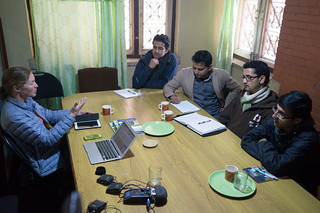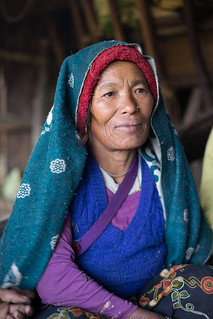As Lindsey wrote, we were mentally unprepared for Nepal. After two and a half months in China, I had forgotten what it is like to be in a country with lagging infrastructure and rolling blackouts. We confronted the poor infrastructure immediately: What we thought would be a one day ride, from the border to Kathmandu, turned into a two day slog due to long stretches of chewed-up or nonexistent pavement. And when we looked for a hotel our first night, we had to search for one that had electricity.
Over our next two and a half weeks, we were reminded over and over that Nepal is a poor country that uses few resources and produces very little electricity. From a climate change perspective, this means that the country produces very little greenhouse gas emissions—but it also means that, as a largely agricultural society with little infrastructure, it is highly vulnerable to a warming climate.
To better understand these issues, while in Kathmandu we spoke with a few NGOs, an intergovernmental organization (ICIMOD), and a government agency. And during our week-long trek in the Annapurna region, we spoke with about a dozen people about how changes in the weather affect them. Here’s what we found from this cursory survey.
Electricity, Energy, and Emissions
Nepal produces very little electricity. If all the country’s power plants were running at full capacity (which is possible only during the rainy season, when there is enough water for the run-of-the-river hydropower plants), there would only be enough electricity for every Nepali to turn on a single, highly efficient, compact florescent lightbulb. No refrigeration, no computers. Just one bulb per person.
Because there isn’t enough electricity, Kathmandu has daily, scheduled, rolling blackouts, such that any given block has electricity for about two-thirds of the day. For this reason, people who can afford it have a battery (or even a generator) to keep the lights on. Many shops use such batteries to power a backup light, such that the streets at night become a row of well-spaced compact florescent bulbs hanging near the front of mostly-dark rooms. The lack of electricity means that instead of traffic lights, men in uniform stand and direct traffic at major intersections. At night these men have green and red light sticks which they wave like lightsabers, as if using the force to move the vehicles. Such power outages also challenge industry—factories need expensive backup generators.
If Nepal is to provide better services for its people, it needs to produce more electricity—much more. The country could accomplish this goal without dramatically increasing its greenhouse gas emissions by building a series of reservoirs in the Himalaya. The economically-feasible hydropower potential is immense—about 40,000 megawatts. That would give Nepalis similar electricity per capita as most western European countries.
But nobody we met in Nepal wanted to dam as many rivers as it would take to reach a fraction of this goal. Employees of Clean Energy Nepal, a local nonprofit, argued that big dams were not the answer—they would displace people and wouldn’t be sustainable because of the heavy sediment load of the Himalayan rivers. They said that they wanted to avoid “China’s path,” and focus on smaller scale solutions. They noted that there are 200 days of sunshine in Nepal per year, making solar a great option (especially in conjunction with small hydro—small hydro works better in the rainy season, solar power works best in the dry season).
We also met with the Alternative Energy Promotion Center, a government agency that promotes clean energy development. They support many small scale projects such as micro-hydro, improved cookstoves, and biogas (more on biogas in a minute). I asked them if they could develop their economy without using fossil fuels. The response was basically “yes, because we can use hydropower.” If they had enough hydropower, they could use the electricity to cook and heat, thus reducing some of the needs for fossil fuel. They said that distributed solar, biogas, and improved cookstoves were part of a solution, but not the entire solution to developing in a clean way—they also needed dams.
Many of these small projects, while not being the entire solution, are improving people’s quality of life without increasing greenhouse gas emissions. One example is the country’s many successful biogas projects. A consultant/researcher at Winrock, an international NGO, told me about how Winrock, other NGOs, and government agencies have helped install biogas digesters all over the country — there are now 300,000 small digesters, which allow people to take cow (or other ruminant) dung and turn it into natural gas for cooking. Using such gas is much more efficient and better for people’s health than burning the dung, which is what most people without digesters do. Two cows can provide four people with enough gas for all their cooking needs. Also, the waste from the digesters can in turn be used as fertilizer. Moreover, Nepal has been paid for the program through the Clean Development Mechanism of the Kyoto Protocol. Basically, it is a win-win-win. (Interestingly, one challenge is that people think that cooking with dung is “clean” and cooking with gas is not — getting people to use these new technologies can be challenging).
Such small-scale projects are great news. In the long run, though, Nepal will likely need much more electricity than they can provide, and the easiest way to do that cleanly is through hydropower. Hopefully the dams needed for this will be built in a sensible way that benefits all Nepalis without causing too much harm to the people and ecosystems in the areas around the proposed reservoirs.
Vulnerability and Changing Monsoons
We asked the employees of Clean Energy Nepal (CEN) what worried them about climate change in Nepal. They said: reduced agricultural output, water scarcity, and weather-related disasters, in that order. The same employees at CEN had recently surveyed 4,000 villages in the country, asking if people were experiencing climate change. The people surveyed said that the rain had become more erratic, in turn making farming more difficult.
At ICIMOD, the Director General, David Molden, told us that people in the mountains are experiencing climate change right now. Here’s an edited version of his interview. The part I found the most compelling is how he compares the urgency of climate change here in Nepal to that felt in the United States. He also noted that climate change is just one of the many problems facing mountain people.
And finally, we went into the mountains on a week-long trek (see Lindsey’s blog entry) and talked directly with people ourselves. We found that people were experiencing exactly what Dr. Molden said they were — the rains had become more unpredictable, and were coming later. Some people said these changes in rainfall made it more difficult to farm; others said it had no influence. Everyone also said that it had gotten warmer, although they were split over whether this was a good or bad thing. Higher in the mountains, some liked the warmth because they could grow more crops. Lower down, many said it was too hot.
I’ve seen a number of different rankings of “countries most vulnerable to climate change,” and Nepal is often near the top. After visiting the country, I can now see why, but I also think the worst effects of climate change aren’t here yet. Our survey suggests that people are noticing that the climate is changing, but for many people in Nepal these changes do not yet pose a dramatic challenge, especially given the many other problems they must cope with on a daily basis. Whether they will pose a dramatic challenge in the future depends both on how the country develops, and on how much the climate changes over the coming decades.












